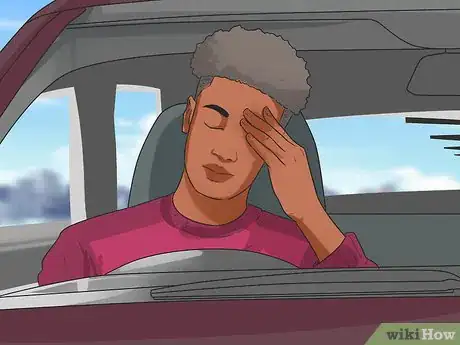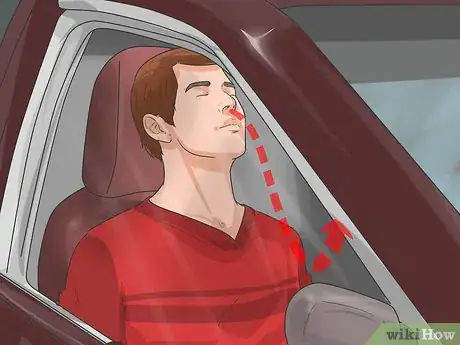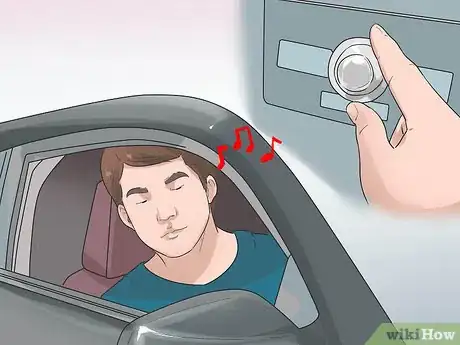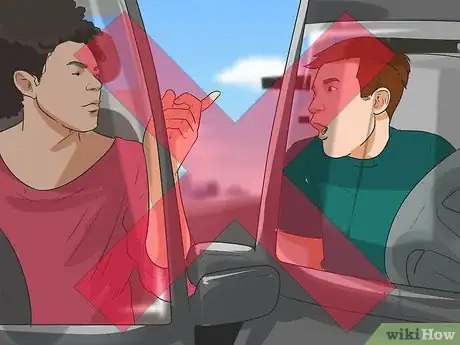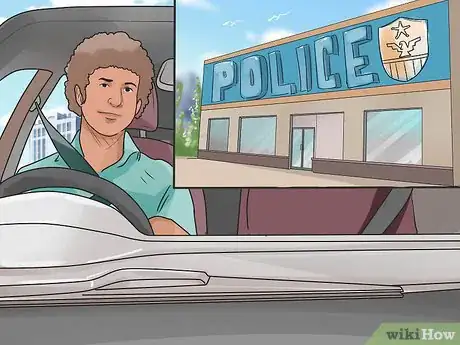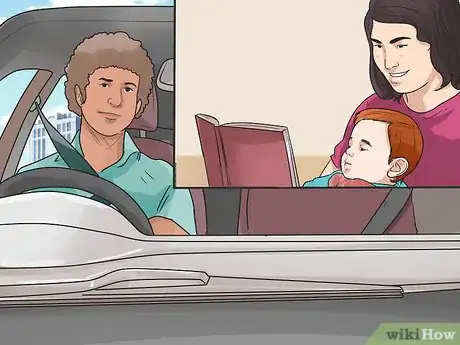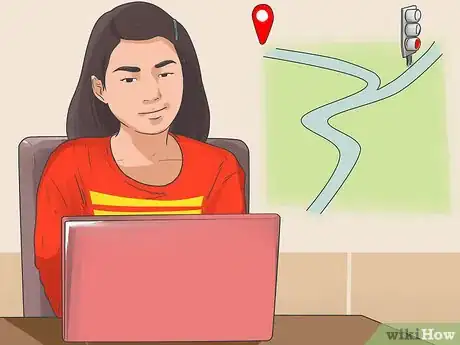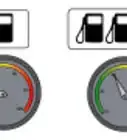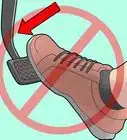This article was co-authored by Trudi Griffin, LPC, MS. Trudi Griffin is a Licensed Professional Counselor in Wisconsin specializing in Addictions and Mental Health. She provides therapy to people who struggle with addictions, mental health, and trauma in community health settings and private practice. She received her MS in Clinical Mental Health Counseling from Marquette University in 2011.
There are 14 references cited in this article, which can be found at the bottom of the page.
wikiHow marks an article as reader-approved once it receives enough positive feedback. In this case, 86% of readers who voted found the article helpful, earning it our reader-approved status.
This article has been viewed 210,456 times.
If you spend any significant amount of time driving for work or leisure, there's a good chance that you've experienced or witnessed some form of road rage.[1] Road rage involves losing your temper over traffic-related situations and includes behaviors like obscene or provocative gestures, yelling, cursing, and tailgating. It can also involve stopping your car and walking up to yell or rant at another driver. In some cases, physical violence is involved, which is something you definitely want to avoid happening. Learning how to keep yourself calm, as well as how to de-escalate someone else's road rage, can help prevent accidents and acts of violence on the road.
Steps
Staying Calm Once You Experience Road Rage
-
1Recognize your rising anger. The most obvious signs of anger are often physical symptoms that emerge after the fact (like voice tone, language, and gestures). But with practice, you'll learn to recognize the warning signs of anger when you mentally check in on yourself.[2]
- Common signs of anger include angry/vengeful thoughts, muscle tension, headaches, or elevated heart rate.
- If you catch yourself speaking out loud (even when you're driving alone) about another driver, you may be experiencing elevated anger.
- By catching yourself as your anger first emerges, you can prevent that anger from turning into aggression or road rage.
-
2Take time to calm down. If you notice yourself feeling angry, it may be best to pull over (if it's safe to do so). Get off the highway or pull over to the shoulder of the road (again, only if it's safe to do this) and put your vehicle in park. Take a few minutes to collect your thoughts and calm yourself down before returning to the road.[3]
- Practice deep breathing or meditation to calm your mind and body after experiencing anger.
- Remember that driving while you're angry puts yourself and others at risk. Even if you're not yet experiencing full-blown road rage, your anger may cause you to drive recklessly and take unnecessary risks.
Advertisement -
3Use deep-breathing techniques. Using deep-breathing exercises can help you calm down and center yourself when you feel angry or tense. Deep breathing is quick and easy, and it can be done while you're driving or stationary.[4]
- Take a long, slow inhalation into your diaphragm over a five-second span. Make sure you're breathing into your diaphragm (below your ribs) and belly instead of just taking shallow breaths in your chest.
- Hold your breath for five seconds
- Exhale slowly over another five-second span.
-
4Listen to calming music. A good way to relax when you start to experience road rage is to listen to soothing music (if you can do so without being distracted). Music can help you calm down and focus on getting to your destination safely.[5]
- Try keeping a few relaxing CDs in an easy to reach spot in your car, or keep your radio tuned to a station that plays calming music. That way you can play music without having to take your eyes off the road.
- Figure out what types of music are most relaxing for you. Try jazz, oldies, and classical music for calm, soothing melodies.
- Avoid listening to fast-paced, aggressive, or angsty music while driving.
-
5Count until you calm down. You may have seen someone in your family or a character in a movie or TV show counting to avoid getting angry. It's an age-old trick to calm down and prevent an outburst, and it may help you in your moment of anger.
- Count upwards for about a minute. If you focus on your breathing and distract yourself with counting, you'll stop actively thinking about the person who wronged you and gradually cool down.
- If you don't feel better after a minute, try counting for another minute. The key is to stop yourself from thinking angry thoughts long enough for your active rage to pass.
-
6Try using "hand yoga". Hand yoga is the act of stretching and tensing/relaxing the muscles in your hands. It may sound strange, but for some people it's an excellent way to relieve stress - just be sure to only take your hands off the wheel when your car is at a complete stop in traffic or at a red light.
- Spread your fingers and stretch out both hands as much as possible.
- Hold this position for a few seconds, then release it.
- Curl each finger individually into your palm, pushing gently with your thumb. Hold it, then release.
- Flex your wrists and bend each knuckle individually to "shake out" the muscles and joints.
-
7Resist the urge to retaliate. If someone cuts you off or is driving too slowly, your initial reaction may be to honk your horn, scream, swear, or use profane gestures. This may make you feel better for an instant, but it will almost certainly aggravate the other driver, and could set you both down a rage-filled path.
- Avoid any inflammatory gestures. This can include honking your horn, flashing your high beams, or extending your middle finger. Each of these may result in an escalated and violent reaction.[6]
- Try to avoid even yelling or screaming. If you shout swear words at another driver and your window happens to be open, there’s a chance that driver could hear you and respond with his own aggression.
-
8Keep your distance. Some people feel compelled to tailgate when they are cut off or otherwise "wronged" by other drivers. This is a potentially dangerous move. Tailgating increases the risk of causing an accident, and it could also trigger the other driver's anger.[7]
- Use the four-second rule. When the car ahead of you passes a sign or lamp post, start counting and slow down so you don't pass that same post until at least four seconds later.
Staying Safe When Others Are Aggressive
-
1Stay calm. If someone is swerving towards you, honking, yelling, or flashing their high beams at you, you may feel scared or anxious. The important thing is to try and remain calm, and do whatever you can to get home safely.
- Keep your own emotions in check when others act aggressively.[8]
- Recognize how you're feeling, and drive as defensively as possible.
- Try making yourself more comfortable to keep calm. Turn on the air conditioning to cool off, and adjust your seating position (if you can do so safely) to get better situated in your vehicle.
- Remember that at the end of the day, it's just traffic. Someone else's bad driving shouldn't ruin your day, but if you lose your temper, it could end up ruining your life.
-
2Refrain from making eye contact. If someone is showing signs of aggression, whether through honking their horn, flashing you with high beams, or just driving aggressively, make sure you avoid eye contact with that person. Experts warn that making eye contact with an enraged driver can be seen by that driver as a sign of aggression, and could usher in escalated attacks.[9]
- Put your signal on to indicate that the other car can pass you (if he is trying to get around you).
- Keep your eyes forward on the road. Do not even glance in the other driver's direction.
-
3Drive defensively. If someone is behaving aggressively, it's best to let that person pass by and be on his way. If that driver is in front of you, you can watch him to ensure your safety.[10] If he's behind you, though, he could follow you or try to escalate things further.[11]
- If the aggressive driver wants to pass you, let him.
- Any time someone wants to merge into your lane, let them. (Assuming you can do so safely.)
- Try to avoid braking suddenly by keeping your eyes on the road at all times and scanning the sides of the road for potential hazards.
- Don't tailgate.
- Avoid blocking traffic, as this may cause other drivers to grow angry or impatient.
-
4Give others the benefit of the doubt. When another driver cuts you off, changes lanes without signaling, swerves towards you, or engages in any other perceived act of aggression, you may assume that person is showing you hostility. However, it's possible that the other driver made a mistake. He may not have seen you, or he may be distracted by some pending family emergency. For all you know he's on his way to the hospital, and not out to get you.[12]
- Remember that humans are capable of making mistakes, even behind the wheel. You've probably made a few yourself.
- Sometimes extreme situations like poor health or the death of a loved one can cause people to act out in ways they may not even recognize.
- Before you assume someone was driving aggressively and honk your horn or make a rude gesture, remember that that person may be experiencing something you're not aware of.
-
5Get help if you need it. If someone is following you and it's clear he intends to engage in some act of aggression, do not go home or to your workplace. That would make you an easy target for violence while also letting the driver know where you live or work. Instead, try to get someplace safe where there are a lot of people, or someplace you know the police can help you.[13]
- Keep your car doors locked and your windows rolled up. Do not get out of the car, no matter how much another driver tries to antagonize you.
- Any time someone follows you, take a detour to get somewhere safe, no matter how late you are.
- Drive to the nearest police station. If the other driver is following you with the intention of assaulting you, he'll think twice before doing so in front of a police station.
- If you can't get to a police station, try getting someplace crowded with people and call the police.
- You should always avoid talking on a phone while driving, but if someone is following you you'll need to call the police before you even think about stopping your vehicle.
-
6Keep your priorities in mind. In the heat of the moment, it may be very tempting to respond to someone's aggression with your own anger. However, this is simply not worth the risk. Many people are injured or killed during road rage-fueled exchanges with other drivers. Remember that responding to anger with anger will only add fuel to the fire.
- Try keeping an image of a loved one taped to your dashboard. This can help remind you of everything you'd lose if you got arrested for assault or killed by someone else's violent outburst.[14]
- Remember that aggressive behavior can lead to your own injury or death, or the injury/death of another person. It's simply not worth the risk.[15]
- Driving is not a contest. You and everyone else on the road ultimately wants to get home safely to your loved ones.[16]
Preventing Your Own Road Rage
-
1Check your mood before driving. If you leave your home or workplace in an angry, irritated, or otherwise upset mood, there's a good chance that a minor traffic incident could set you off. One of the easiest ways to prevent your own road rage is to wait until you're calm enough to drive without feeling emotional or agitated.[17]
- Before you turn the ignition, do a quick mental and emotional check-in with yourself.
- Ask yourself whether anything emotionally upsetting has happened to you in the last few hours. If you're leaving from home, that might mean an argument with your partner or neighbor. If leaving work, it could mean any number of possible events.
- Assess how you are coping with whatever stressors are happening in your day. Think about any times you might have grown impatient with others, lost your temper, or had angry thoughts about another person.
- Find ways to calm down before you drive. If you can safely go for a short walk to clear your head, try doing that. If not, try sitting in your car and meditate for a few minutes until you feel calmer.
-
2Drive when you're awake and sober. Studies show that being overly tired can lead to a loss of emotional control, which can have ramifications when you're behind the wheel. In addition to being well-rested and wakeful, it's important to always drive sober, as alcohol can lower your inhibitions and may lead you to feel angry or belligerent (to say nothing of your impaired driving ability).[18]
- Try keeping snacks on hand in your car, as hunger can sometimes cause frustrated drivers to experience road rage.[19]
- Driving when you're well-rested, fed, and sober is the safest way to travel.
-
3Give yourself extra time. If you're heading someplace important, give yourself a little extra time for traffic. That way you won't be stressed if you get stuck in traffic, and you'll be less likely to end up engaging in road rage behavior.[20]
- You probably know that you should leave early enough to manage your usual commute time, but figuring out traffic may be more difficult.
- Check your local Department of Transportation, police reports, and news updates for any information on current traffic patterns near you. There may be an accident or construction work that you didn't know about.
- Some state Department of Transportation websites offer commuters a travel time calculator. These calculators ask where you're leaving from, where you're heading, and what time you need to arrive by, then cross-check your commute with relevant traffic updates.[21]
-
4Avoid traffic whenever possible. If you live in a rural area, you are probably somewhat limited in your travel options. But if you live in or near a more urban area, you may be able to find a detour around the traffic that's waiting up ahead.
- If you're traveling with at least one other passenger, you may qualify for the car pool lane. Check your local ordinances, however, as some places require a minimum of three occupants in a given car.[22]
- Avoid peak traffic times. This will vary from one city to the next, but traffic is generally at its worst between 7:00 and 10:00 AM and from 3:00 to 7:00 PM.[23]
- Download and use traffic apps. These can detect upcoming traffic jams and reroute you accordingly. Just be sure to set it up before you drive, as driving and fidgeting with your phone could cause an accident.
-
5Take public transit. The surefire way to prevent road rage is to avoid driving in traffic altogether. If you live in or near a big city, there's a good chance that you have access to an affordable public transit system. Even if you don't live in a major metropolitan area like New York City, your city most likely has an extensive network of bus routes, light transit rails, and/or subway lines.[24]
- Taking public transportation takes the stress out of commuting. You can read, listen to music, or simply tune out while the driver deals with traffic.
- Most public transit options are affordable, and when compared to the cost of gas and parking, taking a bus/subway may actually be cheaper than driving.
- Even if your city's public transit lines don't run right to your block, you can walk or bike to the nearest transit stop. Your community may even have park-and-ride options so you can drive to your nearest subway/light rail stop.
- Check your city's public transportation options by searching online for bus/rail systems in your area.
Warnings
- If your children are in the car, try to avoid foul language and bad actions. Remember, they will pick up on that, and demonstrate it themselves.⧼thumbs_response⧽
- Road rage is never safe. Try to remain calm, no matter what.⧼thumbs_response⧽
- Never stop to confront someone. Keep your windows up and your doors locked. Head to the nearest police station or highly-populated area. On the way, drive calmly, and if possible, make at least four right-hand turns (or left in the UK, New Zealand, Australia or Ireland). Your pursuer will likely give up, since you are driving in circles.⧼thumbs_response⧽
- Resist the urge to engage angry drivers. A wave or even a genuine smile might be perceived as sarcastic or antagonizing, and could easily provoke an outraged person further.⧼thumbs_response⧽
- Keep your eyes on the road. Looking away for a second is all that it takes to cause an accident or irritate a road rage-prone driver.⧼thumbs_response⧽
Things You'll Need
- Calming music or audio books
- Photos of loved ones or cherished places
- Air-conditioning if it's hot; heating if it's freezing (keeping at the right temperature can help to keep your temper intact)
- GPS to help find the safest and easiest route between destinations
References
- ↑ http://www.webmd.com/women/features/root-cause-of-road-rage
- ↑ http://www.apa.org/helpcenter/recognize-anger.aspx
- ↑ http://www.apa.org/monitor/jun05/anger.aspx
- ↑ http://www.webmd.com/balance/stress-management/tc/stress-management-breathing-exercises-topic-overview
- ↑ http://www.webmd.com/women/features/root-cause-of-road-rage?page=2
- ↑ https://www.esurance.com/info/car/how-to-avoid-aggressive-drivers
- ↑ http://www.safeny.ny.gov/aggr-ndx.htm
- ↑ http://www.safeny.ny.gov/aggr-ndx.htm
- ↑ http://www.ct.gov/dmv/LIB/dmv/20/29/aggdr.pdf
- ↑ http://health.usnews.com/health-news/articles/2012/08/30/how-to-control-road-rage?page=2
- ↑ http://www.ct.gov/dmv/LIB/dmv/20/29/aggdr.pdf
- ↑ http://www.safeny.ny.gov/aggr-ndx.htm
- ↑ http://www.rospa.com/road-safety/advice/drivers/better-driving/road-rage/
- ↑ http://www.webmd.com/women/features/root-cause-of-road-rage?page=2
- ↑ http://www.safeny.ny.gov/aggr-ndx.htm
- ↑ http://www.ct.gov/dmv/LIB/dmv/20/29/aggdr.pdf
- ↑ http://www.rospa.com/road-safety/advice/drivers/better-driving/road-rage/
- ↑ http://www.webmd.com/women/features/root-cause-of-road-rage?page=2
- ↑ http://health.usnews.com/health-news/articles/2012/08/30/how-to-control-road-rage
- ↑ http://www.rospa.com/road-safety/advice/drivers/better-driving/road-rage/
- ↑ http://www.wsdot.com/traffic/Seattle/TravelTimes/reliability/default.aspx
- ↑ http://www.dot.ca.gov/hq/paffairs/faq/faq79.htm
- ↑ http://www.wherela.com/avoid-la-traffic/
- ↑ http://www.wherela.com/avoid-la-traffic/
